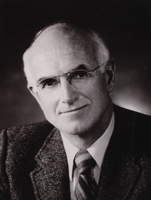Joseph E. Murray
Dublin Core
Title
Subject
Description
Joseph E. Murray was born in 1919 in Milford, Massachusetts. He graduated from Holy Cross College in 1940 and went on to attend Harvard Medical School, receiving his M.D. in 1943. Immediately after graduation he interned at the Peter Bent Brigham Hospital. In 1944, Dr. Murray was inducted into the Medical Corps of the United States Army and assigned to the plastic unit at the Valley Forge General Hospital, where he met Dr. Bradford Cannon and began his career as a plastic surgeon.
Dr. Murray left the military in 1947 and returned to the Peter Bent Brigham Hospital. The Brigham had no formal residency established for plastic surgery, and thus Dr. Murray, upon completion of his general surgical residency, went to New York City for specific training in plastic surgery at the New York and Memorial Hospitals. In 1951, Dr. Murray returned to the Brigham Hospital, joining the surgical staff there. During his experience at the Valley Forge General Hospital, Dr. Murray became interested in the challenges of skin grafting and tissue transplantation. This led to his interest in organ transplant surgery. Upon his return to Boston in 1951, Dr. Murray joined a team of researchers based at the Harvard Medical School and the Brigham Hospital to pursue his interests in solving the problems presented by transplantation. In 1954, he presented techniques to the Boston Surgical Society concerning reconstruction after surgery for head and neck cancer. In the mid- 1960s, Dr. Murray developed new techniques for craniofacial reconstruction.
The training of plastic surgeons flourished under Dr. Murray; today all of Boston's major hospitals train plastic surgeons. Dr. Murray served as the chief plastic surgeon at Peter Bent Brigham Hospital, which later became Brigham and Women's Hospital, until 1986. He also served as the chief plastic surgeon at Children's Hospital from 1972-1985. Dr. Murray served on the faculty of Harvard Medical School, where he retired as Professor of Surgery Emeritus in 1986. Dr. Murray also has served as regent of the American College of Surgeons, chairman of the American Board of Plastic Surgery, and president of the American Association of Plastic Surgeons. In 1990, Dr. Murray became the first plastic surgeon to win the Nobel Prize in physiology or medicine, helping to assure plastic surgery's place in medicine and surgery.
Abstract
Creator
Date Created
Rights
Access Rights
Is Part Of
References
An online guide to the collection is available. Click here.

